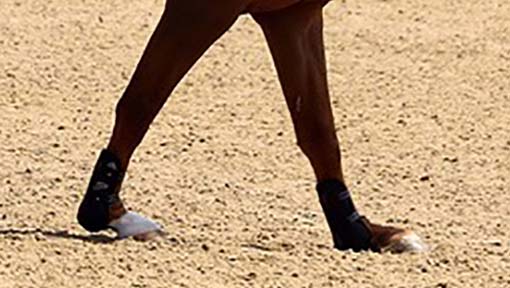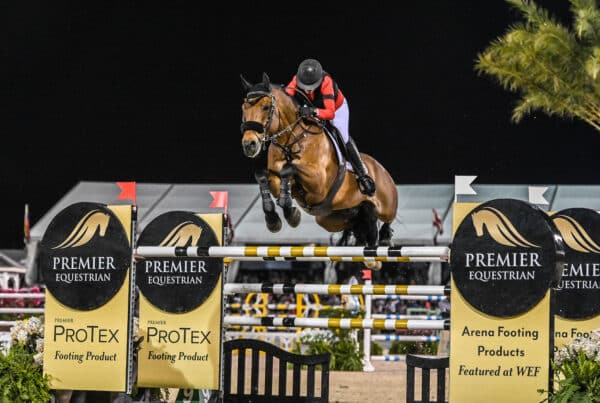When It Comes to Choosing the Right Footing for Your Everyday Riding Surface- Experts Agree: “You Can’t Always Get What You Want …But Sometimes, You’ll Get What You Need”


Last week you competed at a facility with a surface that was perfect for every ride… and there were hundreds of them. A rainstorm even came through and the arena drained quickly and was back in use faster than you expected. Now you’re thinking this is the perfect surface for your arena at home. However, some equestrian professionals and veterinarians agree that the footing at your last horse show is not necessarily what you need at home.
As we prepare for the FEI World Cup Finals 2023 in Omaha—where we will be supplying our Premier ProTex® footing product for the competition and warm-up arenas as the Official Footing Product Provider—we’re sharing the secrets to creating a great horse show surface versus a great home arena surface.
How We Design Horse Show Surfaces
Horse show surfaces are designed with very specific goals in mind. These objectives are different than those you may have for your own arena.
The objectives in designing a competition arena include:
- The surface needs to withstand a lot of horse traffic, all following the same pattern whereas at home riders follow different patterns and use the entire arena more evenly.
- Recover quickly and be rideable soon after horrendous weather whereas a day off the arena at home is inconvenient but not disastrous.
- A more compacted horse show footing can help eliminate ruts or inconsistencies to minimize injury risk and to allow all competitors an equal opportunity to perform at the top of their game.
- Compared with a home arena, a good high-performance competition surface will generally have more grip, firmness and a heavier compaction to maintain evenness between groomings. However, the higher grip and compaction increase concussion which adds to the wear and tear on your horse’s legs if you train on it every day.

“If you have compact competition footing, you can have more horses between two maintenance breaks,” said Markus Fleischmann, manager for OTTO Sport International, who has provided OTTO Sport Arena Base Mats for surfaces at some the sport’s most prestigious venues and competitions, including the Winter Equestrian Festival, Desert International Horse Park, the 2016 Rio de Janeiro Olympics, and the 2010 World Equestrian Games in Lexington, Kentucky.
The footing at horse shows must withstand a lot of traffic. For example, one facility may have 10 competition surfaces with an average of 50 horses per hour for eight to 10-hours a day. That’s 500 rounds per arena. “Competitive venues need a surface that will withstand that kind of traffic and can be maintained efficiently while providing fairness to every rider,” said Heidi Zorn, president of Premier Equestrian. “That’s why we created a specific formula for these horse show arenas, that differs from what we would use for a private facility.”
Riding on a surface with tighter grip and higher compaction is fine for a few days but is not ideal for everyday training. These characteristics are good for performance but if used repeatedly over the long term can cause repetitive strain injuries, such as inflammation and microscopic tears in the tendons and ligaments. Remember, a show facility’s priority is consistency and fairness, but your focus as a rider or trainer should be how the surface affects biomechanics.

A compacted, tight surface does not allow for any hoof slide, leading to an increase in concussive forces.
“A highly compacted surface is never good for the horse long term. For competitions, riders and organizers often put up with the risks as they want to gain the advantages,” Fleischmann said. “For daily training, a more elastic surface is preferred as it is better for the health of the horses.”
The Home Footing You Need
Veterinarians report that critical injuries happen more often at horse shows or events, where the horse may be physically challenged, rather than at home. Naturally there are several factors that might contribute to this statistic, but compacted footing cannot be discarded as part of the challenge.
“Get the best footing you can at home,” said Hilary Clayton, DVM., a researcher, rider and well-respected biomechanics expert. “Ideally, you should have a couple of good, but different surfaces to work on at home.”
“Horses adapt to the characteristics of the surface and will move differently according to the surface type,” Clayton explained. “An obvious example is a horse that is slightly arthritic or footsore will shorten his stride to reduce concussive forces on a harder surface.”
Of course, horses perform better when they are accustomed to the surface they’ll be showing on but this doesn’t mean they need to train on it all the time; once a week or a few occasions prior to a show is sufficient. With that said, most riders spend 90 percent of their riding time at home, so it is critical to get the footing right. By building a training surface with biomechanics in mind, the horse will be better equipped to handle a not-so-perfect surface for one or two days.
Olympic dressage rider and Premier Equestrian Ambassador Adrienne Lyle knows how critical it is to have good footing; she trains on a Premier Equestrian surface at TyL Dressage in Colorado and Florida. She can’t risk an injury when bringing along her young horses or her seasoned show partners. “When you have good footing and a good base you can choose the consistency,” Lyle said. “You can make it firmer or softer through the way you maintain it. I ride daily on an optimum surface and then a few days before the show I will groom the arena to be a little more compact to prepare my horses for the tighter surface”.


The Mighty Four
For daily training there are four surface characteristics that have been proven to contribute to long-term soundness, reduce stress and inflammation.
The 4 surface characteristics you need to consider are:
- Firmness: The firmness, or hardness, of the surface affects the amount of support for the hoof and also the amount of concussion during the landing phase.
- Cushioning: Cushioning refers to how the arena layers dampen loading during the weight-bearing phase of a horse’s stride. Too much cushioning makes it difficult for the horse to generate propulsion.
- Rebound: This refers to the resiliency of the surface to return to its original form, returning energy after the weight of the horse is applied. When rebound is appropriate it reduces the horse’s energy expenditure.
- Grip: The tightness of the surface affects grip. Moderate grip aids in absorbing shock during the landing phase and provides support and traction during push off and on turns. Too much grip stops the hoof abruptly at landing and increases concussion.
Creating a riding surface that fulfills the four characteristics mentioned above depends on several factors:
SAND
The most critical factor is sourcing the correct sand. Not every kind of sand is suitable for all riding arenas. Sand that is well suited for a highly-maintained indoor riding arena might be completely unsuitable for an all-weather, low-maintenance outdoor riding arena. The type of sand is somewhat dependent on what’s available locally since it’s very expensive to ship large amounts of sand.
“Choosing the wrong sand for riding arenas can create problems and be very expensive over time, which is why Premier offers a free Arena Sand Analysis,” explains Zorn. START YOUR FREE ARENA SAND ANALYSIS
ARENA BASE SYSTEMS
Along with the right sand, “The base has to be good,” affirms Clayton. Good footing cannot compensate for deficiencies in the base, so selecting the proper arena base system is also key.
FOOTING ADDITIVES
The next challenge is to choose an appropriate footing additive for the sand. Together, the sand and additive will impact the amount of time it takes to install and regularly maintain the footing.
WATER
You’ll also need to know your watering capacity and how you’ll be using the arena after installation. Facilities that use their riding areas for lunging or turnout will likely need different surface formulations. Watering options range from sprinkler systems to the Premier Equestrian Water Wagon Trailer to our Arion Ebb & Flow Arena System.
WEATHER
Weather is also a factor. Some footing is fine when it’s dry but if there’s a heavy rain it can become slippery and unsafe—which is where our Arion Ebb & Flow Arena System can be beneficial; it drains water quickly during heavy rainstorms and maintains perfect hydration in the footing layer year-round.
One benefit to using synthetic additives is their ability to stay more consistent and stable in different weather conditions. “It can be stormy and rainy or hot and dry and our footing is still good and safe to ride on because it was designed well from the start,” notes Lyle.
Partners in Engineering the Best Surface
Designing a footing solution that meets all your criteria—maintenance program, available materials, budget, and discipline—is a process. It can be tempting to rush through the planning stage but taking the time to evaluate your needs and match those priorities to an appropriate surface material will lead to greater satisfaction once the project is complete.
“Reputable companies focus on engineering an arena surface that meets your needs and serves to protect the horses that will be ridden on it”, explains Zorn. “We can support the process of correct rehabilitation of an existing arena or guide a customer through the process of building a new arena surface. We have a variety of solutions for all budgets.”
In the end the right surface for your arena might not only be different than what you thought you wanted, it may also be a lot better for your horse… and exactly what you need.
SCHEDULE A FREE FOOTING CONSULTATION
©2023 Premier Equestrian, Inc. All Rights Reserved.




